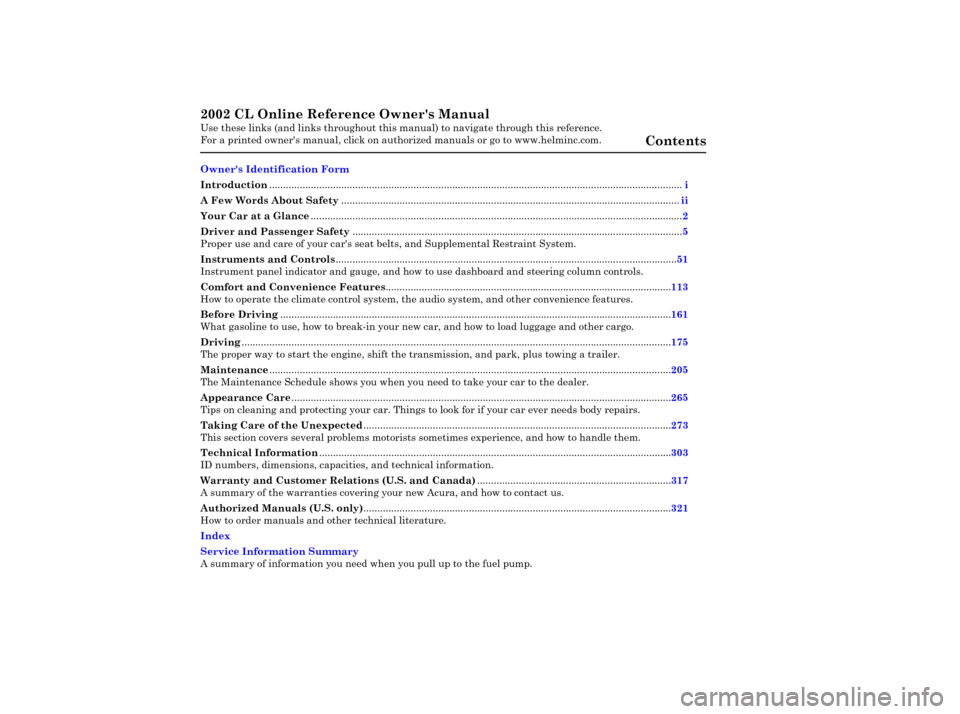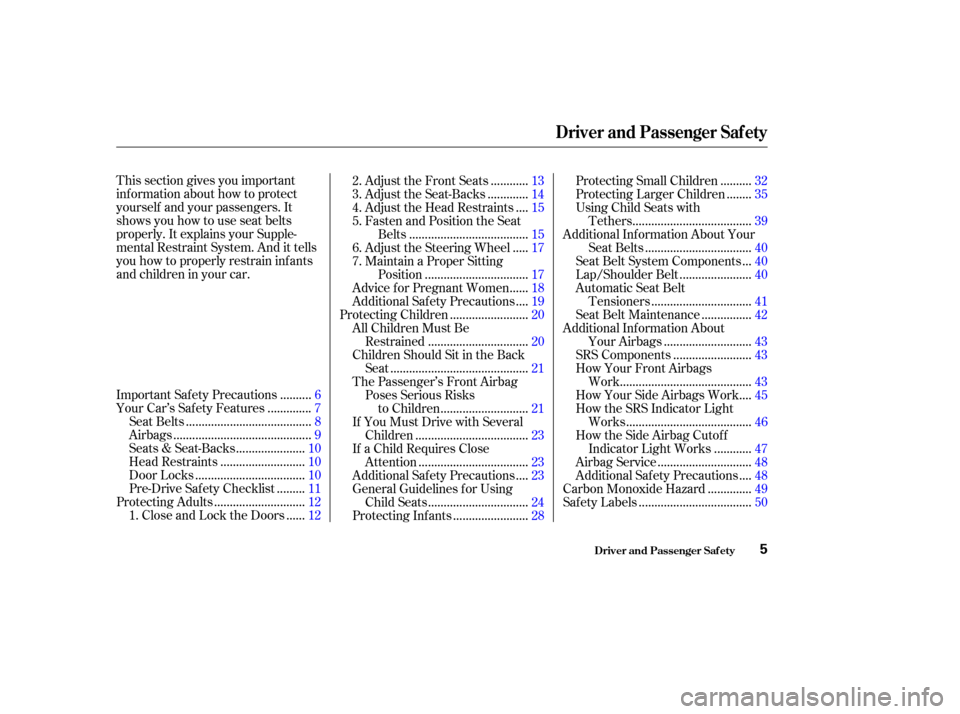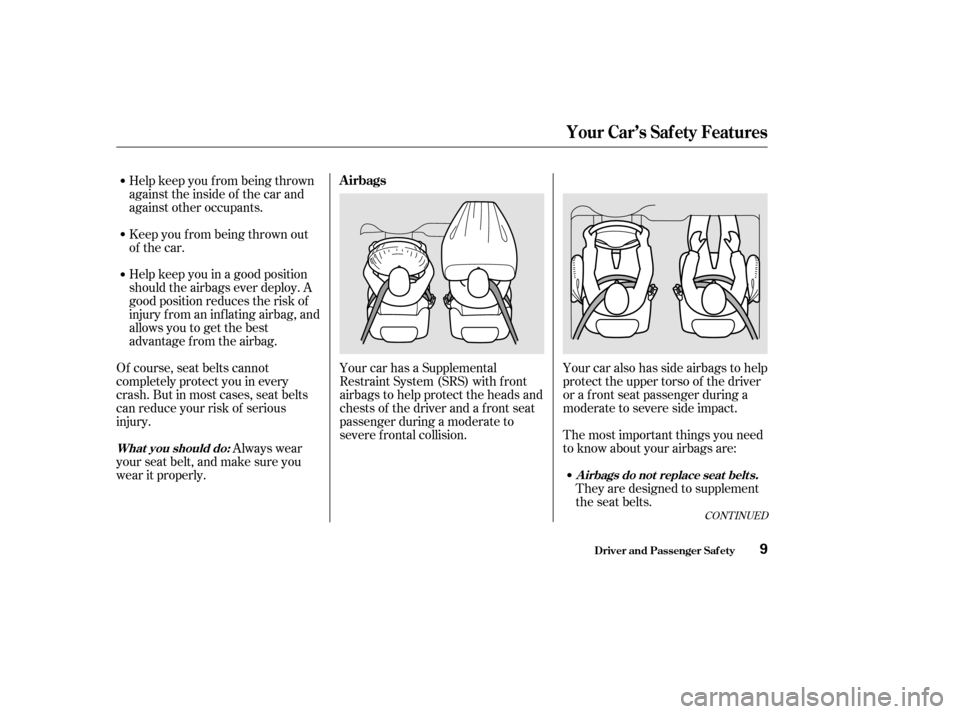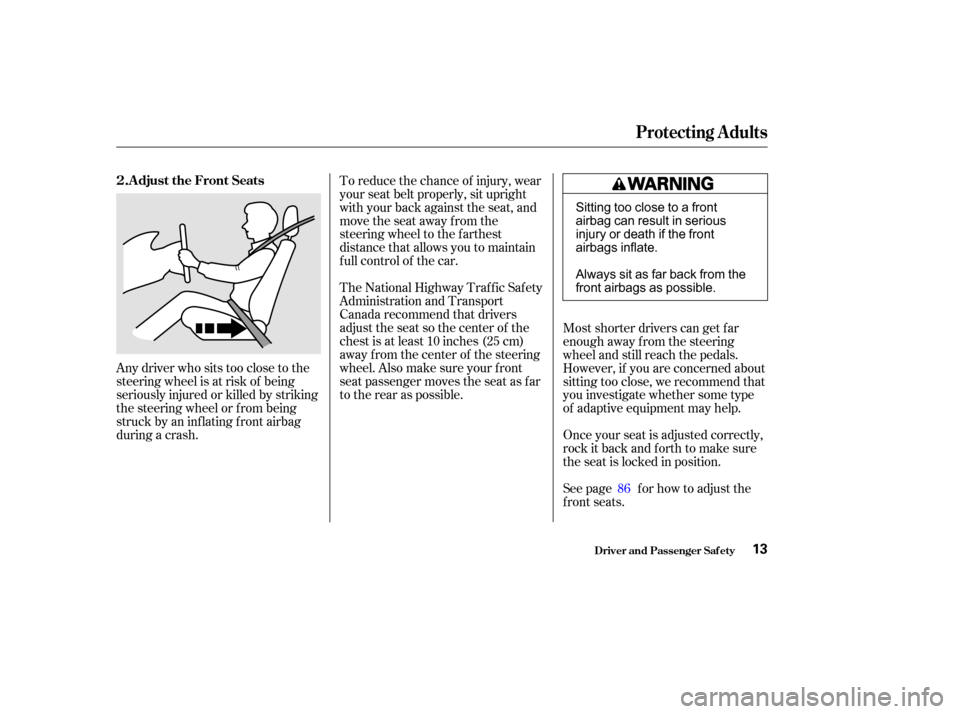belt Acura CL 2002 Owner's Manual
[x] Cancel search | Manufacturer: ACURA, Model Year: 2002, Model line: CL, Model: Acura CL 2002Pages: 335
Page 1 of 335

2002 CL Online Reference Owner's Manual Use these links (and links throughout this manual) to navigate through this reference.
For a printed owner's manual, click on authorized manuals or go to www.helminc.com.
Contents
Owner's Identification Form
Introduction........................................................................\
............................................................................. i
A Few Words About Safety ........................................................................\
.................................................. ii
Your Car at a Glance ........................................................................\
.............................................................. 2
Driver and Passenger Safety ........................................................................\
............................................... 5
Proper use and care of your car's seat belts, and Supplemental Restraint System.
Instruments and Controls ........................................................................\
................................................... 51
Instrument panel indicator and gauge, and how to use dashboard and steering column controls.
Comfort and Convenience Features ........................................................................\
............................... 113
How to operate the climate control system, the audio system, and other convenience features.
Before Driving ........................................................................\
..................................................................... 161
What gasoline to use, how to break-in your new car, and how to load luggage and other cargo.
Driving ........................................................................\
................................................................................... 175
The proper way to start the engine, shift the tr ansmission, and park, plus towing a trailer.
Maintenance ........................................................................\
......................................................................... 205
The Maintenance Schedule shows you when you need to take your car to the dealer.
Appearance Care ........................................................................\
................................................................. 265
Tips on cleaning and protecting your car. Things to look for if your car ever needs body repairs.
Taking Care of the Unexpected ........................................................................\
....................................... 273
This section covers several problems motorists someti mes experience, and how to handle them.
Technical Information ........................................................................\
....................................................... 303
ID numbers, dimensions, capaciti es, and technical information.
Warranty and Customer Relations (U.S. and Canada)......................................................................317
A summary of the warranties covering yo ur new Acura, and how to contact us.
Authorized Manuals (U.S. only) ........................................................................\
....................................... 321
How to order manuals and other technical literature.
Index
Service Information Summary
A summary of information you need wh en you pull up to the fuel pump.
Page 8 of 335

This section gives you important
inf ormation about how to protect
yourself and your passengers. It
shows you how to use seat belts
properly. It explains your Supple-
mental Restraint System. And it tells
you how to properly restrain inf ants
andchildreninyourcar..........
Important Safety Precautions . 6
.............
Your Car’s Saf ety Features . 7
.......................................
Seat Belts .8
...........................................
Airbags .9
.....................
Seats & Seat-Backs .10
..........................
Head Restraints .10
..................................
Door Locks .10
........
Pre-Drive Saf ety Checklist . 11
............................
Protecting Adults .12
.....
1. Close and Lock the Doors . 12 ...........
2. Adjust the Front Seats . 13
............
3. Adjust the Seat-Backs . 14
...
4. Adjust the Head Restraints . 15
5. Fasten and Position the Seat .....................................
Belts .15
....
6. Adjust the Steering Wheel . 17
7. Maintain a Proper Sitting ................................
Position .17
.....
Advice f or Pregnant Women . 18
...
Additional Safety Precautions . 19
........................
Protecting Children .20
All Children Must Be ...............................
Restrained .20
Children Should Sit in the Back ...........................................
Seat .21
The Passenger’s Front Airbag Poses Serious Risks ...........................
to Children .21
If You Must Drive with Several ...................................
Children .23
If a Child Requires Close ..................................
Attention .23
...
Additional Safety Precautions . 23
General Guidelines f or Using ...............................
Child Seats .24
.......................
Protecting Inf ants .28 .........
Protecting Small Children . 32
.......
Protecting Larger Children . 35
Using Child Seats with .....................................
Tethers .39
Additional Inf ormation About Your .................................
Seat Belts .40
..
Seat Belt System Components . 40
......................
Lap/Shoulder Belt .40
Automatic Seat Belt ...............................
Tensioners .41
...............
Seat Belt Maintenance . 42
Additional Inf ormation About ...........................
Your Airbags .43
........................
SRS Components .43
How Your Front Airbags .........................................
Work .43
...
How Your Side Airbags Work . 45
How the SRS Indicator Light .......................................
Works .46
How the Side Airbag Cutof f ...........
Indicator Light Works . 47
.............................
Airbag Service .48
...
Additional Safety Precautions . 48
.............
Carbon Monoxide Hazard . 49
...................................
Saf ety Labels .50
Driver and Passenger Saf ety
Driver and Passenger Saf ety
5
Page 9 of 335

You’ll f ind many saf ety
recommendations throughout this
section, and throughout this manual.
Therecommendationsonthispage
are the ones we consider to be the
most important.Excessive speed is a major f actor in
crash injuries and deaths. Generally,
the higher the speed the greater the
risk, but serious accidents can also
occur at lower speeds. Never drive
f aster than is saf e f or current
conditions, regardless of the
maximum speed posted.
A seat belt is your best protection in
all types of collisions. Airbags
supplement seat belts, but airbags
are designed to inf late only in a
moderate to severe f rontal collision.
So even though your car is equipped
with airbags, make sure you and
your passengers always wear your
seat belts, and wear them properly.
(See page .)
Children are saf est when they are
properly restrained in the back seat,
notthefrontseat.Achildwhoistoo
smallforaseatbeltmustbeproperly
restrained in a child saf ety seat. (See
page .) Having a tire blowout or a
mechanical f ailure can be extremely
hazardous. To reduce the possibility
of such problems, check your tire
pressures and condition f requently,
and perform all regularly scheduled
maintenance. (See page .)
Alcohol and driving don’t mix. Even
one drink can reduce your ability to
respond to changing conditions, and
your reaction time gets worse with
every additional drink. So don’t drink
and drive, and don’t let your f riends
drink and drive, either. While airbags can save lives, they
can cause serious or fatal injuries to
occupants who sit too close to them,
or are not properly restrained.
Inf ants, young children, and short
adults are at the greatest risk. Be
sure to f ollow all instructions and
warnings in this manual. (See page
.)
9
15
20 208
Driver and Passenger Saf ety
Important Saf ety Precautions
Always Wear Your Seat Belt
Be Aware of Airbag Hazards Control Your Speed
K eep Your Car in Saf e Condition
Restrain All Children Don’t Drink and Drive
6
Page 10 of 335

Your car is equipped with many
features that work together to
protect you and your passengers
during a crash.
Some saf ety f eatures do not require
anyactiononyourpart.These
include a strong steel f ramework
that forms a safety cage around the
passenger compartment; f ront and
rear crush zones that are designed to
crumple and absorb energy during a
crash; a collapsible steering column;
and seat belt tensioners that
automatically tighten the front seat
belts in the event of a crash.
CONT INUED
Driver and Passenger Saf ety
Your Car’s Saf ety Features
7
( (5
5) )(
(
7
7) )(
(
6
6) )
(
( 2
2) )
(
(
1
1) )
(
(9
9) ) (
(
8
8) )
(
(
1
10 0)) (
(3
3) )
(
( 8
8) )
(
(2
2) )
(
(
7
7) ) (
(
4
4) )
(
(
6
6) )
(
(1
1) ) S
Sa affe
et tyy C
Caagg e
e
(
( 2
2) ) C
Cr ruu s
shh Z
Zo
on
ne
ess
(
( 3
3) ) S
Se eaattss &
& S
Seeaatt--B
Ba acckks s
(
( 4
4) ) H
H e
eaadd R
Reessttrraai inn t
tss
(
( 5
5) ) C
Co ol
lllaap p s
siibb l
lee S
Stteee erriinn g
g C
Cool
luu m
m n
n
(
( 6
6) ) S
Se eaatt B
Be elltts s
(
( 7
7) ) F
Frroo n
nt
t A
A i
irrb b a
agg s
s
(
( 8
8) ) S
Si idd e
e A
Ai
irrb b a
agg s
s
(
( 9
9) ) S
Se eaatt B
Be elltt T
Te
enn s
siioo n
ne
errss
(
( 1
10 0)) D
D o
oo
or
r L
Loo c
ckks s
Page 11 of 335

In addition, most states and all
Canadian provinces require you to
wear seat belts.
When properly worn, seat belts:Help protect you in almost every
type of crash, including f rontal,
side, and rear impacts and
rollovers.
Foryoursafety,andthesafetyof
your passengers, your car is
equipped with seat belts in all seating
positions.
Seat belts are the single most
effectivesafetydeviceforadultsand
larger children. (Inf ants and smaller
children must be properly restrained
in child seats.)
Not wearing a seat belt properly
increases the chance of serious
injury or death in a crash, even
though your car has airbags.
Your seat belt system also
includes a light on the
instrument panel to remind you and
your passengers to f asten your seat
belts.
Keep you connected to the vehicle
so you can take advantage of the
vehicle’s built-in saf ety f eatures.
These saf ety f eatures are designed
to reduce the severity of injuries in a
crash. However, you and your
passengers can’t take f ull advantage
of these saf ety f eatures unless you
remain sitting in a proper position
and
In f act, some saf ety
f eatures can contribute to injuries if
they are not used properly.
Driver and Passenger Saf ety
Your Car’s Saf ety Features
Seat Belts
Why Wear Seat Belt s
always wear your seat belts
properly.
8
Not wearing a seat belt properly
increases the chance of serious
injury or death in a crash, even
if you have airbags.
Be sure you and your
passengers always wear seat
belts and wear them properly.
Page 12 of 335

Your car also has side airbags to help
protect the upper torso of the driver
or a f ront seat passenger during a
moderate to severe side impact.
The most important things you need
to know about your airbags are:They are designed to supplement
the seat belts.
Your car has a Supplemental
Restraint System (SRS) with f ront
airbags to help protect the heads and
chests of the driver and a front seat
passenger during a moderate to
severe f rontal collision.
Help keep you f rom being thrown
against the inside of the car and
against other occupants.
Keep you f rom being thrown out
of the car.
Help keep you in a good position
should the airbags ever deploy. A
good position reduces the risk of
injury f rom an inf lating airbag, and
allows you to get the best
advantage f rom the airbag.
Of course, seat belts cannot
completely protect you in every
crash.Butinmostcases,seatbelts
can reduce your risk of serious
injury. Always wear
your seat belt, and make sure you
wear it properly.
CONT INUED
Driver and Passenger Saf ety
Your Car’s Saf ety Features
Airbags do not replace seat belts.
What you should do:
Airbags
9
Page 13 of 335

Keeping your doors locked reduces
thechanceof beingthrownoutof
the car during a crash. It also helps
prevent occupants f rom accidentally
opening a door and f alling out, and
outsiders f rom unexpectedly opening
your doors. Head restraints can help protect you
f rom whiplash and other injuries. For
maximum protection, the back of
your head should rest against the
center of the head restraint.Move the f ront
seats as far back as possible, and
keep adjustable seat-backs in an
upright position whenever the car is
moving.
Your car’s seats are designed to keep
you in a comf ortable, upright
position so you can take f ull
advantage of the protection offered
by seat belts and the energy
absorbing materials in the seats.
How you adjust your seats and seat-
backs can also affect your safety. For
example, sitting too close to the
steering wheel or dashboard
increases the risk of you or your
passenger being injured by striking
theinsideof thecar,orbyan
inf lating airbag.
Reclining a seat-back too f ar reduces
the seat belt’s ef f ectiveness and
increases the chance that the seat’s
occupant will slide under the seat
belt in a crash and be seriously
injured.
To do their job, airbags must
inf late with tremendous f orce and
speed. So while airbags help save
lives, they can cause minor injuries,
or more serious or even fatal
injuries if occupants are not
properly restrained or sitting
properly.
Always wear
your seat belt properly, and sit
upright and as f ar back as possible
f rom the steering wheel or
dashboard.
Driver and Passenger Saf ety
Your Car’s Saf ety Features
Door L ocks Head Restraints
Seats & Seat-Backs
What you should do:
A irbags of f er no prot ect ion in rear
impact s, rollovers, or minorf ront al or side collisions.
Airbags can pose serious hazards.
What you should do:
10
Page 14 of 335

All adults, and children who have
outgrown child saf ety seats, are
wearing their seat belts and
wearingthemproperly(seepage).
Any inf ant or small child is
properly restrained in a child seat
inthebackseat(seepage ).
To make sure you and your
passengers get the maximum
protection f rom your car’s saf ety
f eatures, check the f ollowing each
time before you drive away:
The rest of this section gives more
detailed inf ormation about how you
can maximize your saf ety.
Remember, however, that no saf ety
system can prevent all injuries or
deaths that can occur in severe
crashes, even when seat belts are
properly worn and the airbags deploy.
Head restraints are properly
adjusted (see page ). Frontseatoccupantsaresitting
upright and as f ar back as possible
f rom the steering wheel and
dashboard (see page ).
All cargo is properly stored or
secured (see page ). Seat-backs are upright (see page
).
Both doors are closed and locked
(see page ).
15
20 13
14 15
12 171
Driver and Passenger Saf ety
Pre-Drive Saf ety Checklist
Your Car’s Saf ety Features
11
Page 15 of 335

The f ollowing pages provide
instructions on how to properly
protect the driver and other adult
occupants.
These instructions also apply to
children who have outgrown child
seats and are large enough to wear
lap/shoulder belts. (See page f or
important additional guidelines on
how to properly protect larger
children.)For security, locked doors can
prevent an outsider f rom
unexpectedly opening a door when
you come to a stop.
See page f or how to lock the
doors.
For saf ety, locking the doors reduces
the chance that a passenger,
especially a child, will open a door
while the car is moving and
accidentally f all out. It also reduces
the chance of someone being thrown
out of the car during a crash. Your car has a door monitor light on
the instrument panel to indicate
when a specif ic door is not tightly
closed. Af ter everyone has entered the car,
be sure the doors are closed and
locked.
35 77
Driver and Passenger Saf ety
Protecting Adults
Introduction
Close and L ock the Doors
1.
12
Page 16 of 335

Any driver who sits too close to the
steering wheel is at risk of being
seriously injured or killed by striking
the steering wheel or f rom being
struck by an inflating front airbag
during a crash.To reduce the chance of injury, wear
your seat belt properly, sit upright
with your back against the seat, and
movetheseatawayfromthe
steering wheel to the f arthest
distance that allows you to maintain
f ull control of the car.
The National Highway Traffic Safety
Administration and Transport
Canada recommend that drivers
adjust the seat so the center of the
chest is at least 10 inches (25 cm)
away f rom the center of the steering
wheel.Alsomakesureyourfront
seat passenger moves the seat as f ar
to the rear as possible.
See page f or how to adjust the
f ront seats. Once your seat is adjusted correctly,
rock it back and f orth to make sure
the seat is locked in position. Most shorter drivers can get f ar
enough away f rom the steering
wheel and still reach the pedals.
However, if you are concerned about
sitting too close, we recommend that
you investigate whether some type
of adaptive equipment may help.86
Driver and Passenger Saf ety
Protecting Adults
Adjust the Front Seats
2.
13
Sitting too close to a front
airbag can result in serious
injury or death if the front
airbags inflate.
Always sit as far back from the
front airbags as possible.